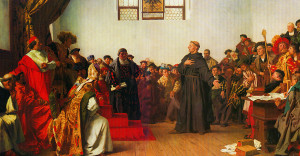by Dr. Jack Kilcrease

Although in modern parlance, the term “martyr” has come to mean a person who suffers and dies for a cause, the original meaning of the Greek word is merely “a witness.” Throughout the early Church one of the main ways that people testified to their faith was through suffering and death at the hands of the Romans. In doing this, they imitated the supreme martyr, their Lord and master, Jesus. For many, the death of the martyr served as an important confirmation of the Christian faith, since the apostles and other later Christians proved the power and sincerity of their witness to Jesus by being willing to die for it.
Before discussing martyrdom at the time of the Reformation, it must be understood that heresy in the early sixteenth century was a capital crime. Unlike in modern America and Western Europe, it was believed in the sixteenth century that a nation could not remain united without a common religion. This is because religion was not considered to be a mere private or subjective opinion. Rather, religion was understood to constitute a way of life and a key basis for the political order. For this reason, the Roman Catholic Church at the Fourth Lateran Council (1215) insisted that secular rulers must enforce Christian orthodoxy through coercive measures. To assist in this, the Inquisition was also established later in that same century.
Among the many Lutherans that suffered and died as witnesses to the truth of the Lutheran Reformation, Heinrich Möller (popularly known as Brother Henry of Zütphen) is worth mentioning. Brother Henry was a Dutch member of the Augustinian Order, the same mendicant order to which Luther belonged. To pursue a theological education he eventually became a student at Wittenberg in 1516. There he studied under Luther and absorbed his reformational ideas. After the Reformation was well underway in the early 1520’s, Brother Henry returned to the Netherlands where he held several high offices in the Augustinian Order. At this time, the Netherlands were part of the Holy Roman Empire and Charles V’s Edict of Worms (which had outlawed Luther and his teaching) was also being enforced in the Low Countries.
Because Henry’s Lutheran opinions were well-known, he was persecuted and finally forced to not only leave his position, but Holland altogether. Seeking to return to Wittenberg, he got as far as the German city of Bremen where he and his reformational ideas had a warm reception. After having spent some time there and feeling that the Reformation had been sufficiently established in the city, Henry traveled to Meldorf in what is modern Denmark. Although those who had invited him to the city were receptive to his message, the civil and ecclesiastical authorities were still very opposed to Lutheranism. After suffering a large amount of opposition, Brother Henry was eventually arrested, tried, and burned at the stake the next day. Luther was extremely distressed at hearing of his former student’s death and wrote a short treatise celebrating Henry’s witness to the gospel.
Another Lutheran martyr worth mentioning is the Scottish Lutheran Sir Patrick Hamilton. Hamilton was born the diocese of Glasgow and eventually attended the University of Paris. In 1520, while engaged in graduate studies, he was exposed to Lutheran preaching and Luther’s writings. As a result of this, he left Paris and moved onto Leuven, a university famous because of its association with the humanist Erasmus, who had in small measures encouraged church reform. Completing his graduate work, Hamilton returned to Scotland where he became a member of the Faculty of Arts at St. Andrews University. He used his academic position to promote his newly found Lutheran views. This led to a probe by James Beaton, the local archbishop. Hamilton fled back to the continent to study at the University of Marburg.
In spite of the danger, Hamilton eventually returned to Scotland. He set himself up in his brother’s house, married, and began to publicly preach Lutheran sermons. He was particularly zealous in his promotion of the Lutheran distinction between law and gospel. In response, the local archbishop gathered together a council of the clergy and charged Hamilton with heresy. Hamilton was then handed over to the civil authorities and burned at the stake the same day in order to prevent any attempts at rescuing him. Hamilton’s death was not in vain, but led people to take notice and investigate the teachings of the Reformation.
These early Lutheran martyrs were important because they died witnessing to the power of the gospel to forgive and transform believers. By being willing to die for the truth of their confession, they caused others to take notice of what they had confessed. They thereby brought many to repentance and faith.
Dr. Jack Kilcrease is a member of Our Savior Lutheran Church, Grand Rapids, Mich.